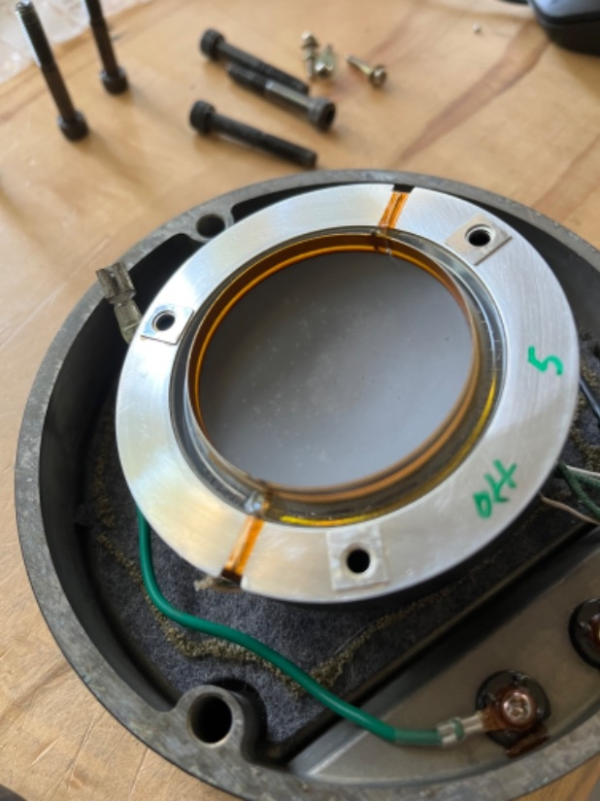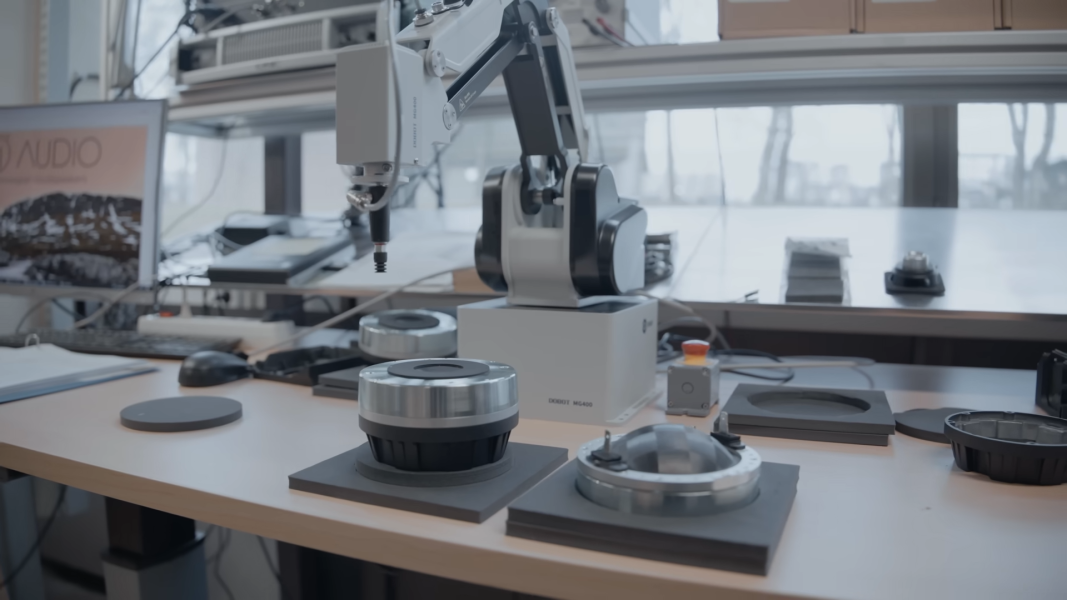I am told the level of the tweeter can be adjusted +1 or -1 db from neutral, and at the show was in the +1 position. ability to tweak to taste or room conditions always a good thing.The Vyger system sounded a bit strident to me, especially in the treble, probably not helped by being played too loud IMO. For anyone interested, there is a pair of the speakers for sale in the UK currently.
MUNCHEN 2025 MOC / MARRIOTT The final Chapter !
- Thread starter andromedaaudio
- Start date
You are using an out of date browser. It may not display this or other websites correctly.
You should upgrade or use an alternative browser.
You should upgrade or use an alternative browser.
The Vyger system sounded a bit strident to me, especially in the treble, probably not helped by being played too loud IMO. For anyone interested, there is a pair of the speakers for sale in the UK currently.
It's also a beryllium tweeter, which may or may not be problematic. I have moved from beryllium tweeter to soft dome.
There was zero brightness or strident sound when I heard it outside Munich
This is Sujay’s comment on hearing them in Rome.
Post in thread 'V.Y.G.E.R indian signature & VYDA cables.'
https://www.whatsbestforum.com/threads/v-y-g-e-r-indian-signature-vyda-cables.37286/post-900699
This is Sujay’s comment on hearing them in Rome.
Post in thread 'V.Y.G.E.R indian signature & VYDA cables.'
https://www.whatsbestforum.com/threads/v-y-g-e-r-indian-signature-vyda-cables.37286/post-900699
The bland music virus at shows has absolutely nothing to do whether they’re playing digital or vinyl. (Must EVERYTHING be viewed along the digital/analog continuum ad infininitum?).Manuel Huber is such a relief in that regard .
Playing old vinyl / real music / artists and with good stories from the sixties / seventies over the music bizz.
Most try to impress instead with polished digital soundtracks
The fact is, most of the manufacturers or distributors are weenies playing it safe to the lowest common denominator. From what I can see in vids, audio shows are pretty much an anti-musical experience.
Wise decision.It's also a beryllium tweeter, which may or may not be problematic. I have moved from beryllium tweeter to soft dome.
Could you please develop this point of view? (Same for @Al M. )Wise decision.
Thanks
I like the best textile dome tweeters very much. But I also like some beryllium tweeters. For instance, the one used in the Magico Q1 monitor impressed me by its stunning "rightness" (though I know one which lacks "density", and another one that produces sibilance on voices, specifically Ssss and Chchch - I am sensitive to screechy treble; I attend live unamplified concerts nearly every week)
[please forgive my poor English]
Last edited:
Sure.
It's about the speed of sound through materials in general and about inherent damping properties.
At a deeper level (subdomain #1) there are the reciprocal effects between, in this case, the dome itself and the suspension.
Beryllium is theoretically the ultimate material for the reproduction of mid and high frequencies, because of the speed of sound (approx. 12,890 m/s) and the associated properties including high stiffness and low mass.
And herein lies the issue. Simply put, Beryllium is actually too good for a natural reproduction of HF sound.
The difference between the material properties of a Beryllium dome and almost all cone materials is so great that it's almost impossible to achieve a sonically homogeneous whole.
This phenomenon was noticeable in almost all systems that I have listened to with a Be HF unit; an obvious disjunction between the highs and the low/mid band.
It's about the speed of sound through materials in general and about inherent damping properties.
At a deeper level (subdomain #1) there are the reciprocal effects between, in this case, the dome itself and the suspension.
Beryllium is theoretically the ultimate material for the reproduction of mid and high frequencies, because of the speed of sound (approx. 12,890 m/s) and the associated properties including high stiffness and low mass.
And herein lies the issue. Simply put, Beryllium is actually too good for a natural reproduction of HF sound.
The difference between the material properties of a Beryllium dome and almost all cone materials is so great that it's almost impossible to achieve a sonically homogeneous whole.
This phenomenon was noticeable in almost all systems that I have listened to with a Be HF unit; an obvious disjunction between the highs and the low/mid band.
Sure.
It's about the speed of sound through materials in general and about inherent damping properties.
At a deeper level (subdomain #1) there are the reciprocal effects between, in this case, the dome itself and the suspension.
Beryllium is theoretically the ultimate material for the reproduction of mid and high frequencies, because of the speed of sound (approx. 12,890 m/s) and the associated properties including high stiffness and low mass.
And herein lies the issue. Simply put, Beryllium is actually too good for a natural reproduction of HF sound.
The difference between the material properties of a Beryllium dome and almost all cone materials is so great that it's almost impossible to achieve a sonically homogeneous whole.
This phenomenon was noticeable in almost all systems that I have listened to with a Be HF unit; an obvious disjunction between the highs and the low/mid band.
Interesting observation. I would agree with the disjunction in many, though not all cases.
What about speakers using Be lower down in the range, down to say 300-400hz like in a large format compression driver?Sure.
It's about the speed of sound through materials in general and about inherent damping properties.
At a deeper level (subdomain #1) there are the reciprocal effects between, in this case, the dome itself and the suspension.
Beryllium is theoretically the ultimate material for the reproduction of mid and high frequencies, because of the speed of sound (approx. 12,890 m/s) and the associated properties including high stiffness and low mass.
And herein lies the issue. Simply put, Beryllium is actually too good for a natural reproduction of HF sound.
The difference between the material properties of a Beryllium dome and almost all cone materials is so great that it's almost impossible to achieve a sonically homogeneous whole.
This phenomenon was noticeable in almost all systems that I have listened to with a Be HF unit; an obvious disjunction between the highs and the low/mid band.
So far in my experiments with compression drivers, I have preferred Ti and Al over Be, at least when it’s only around 2Khz and up.
Could you please develop this point of view? (Same for @Al M. )
Thanks
I like the best textile dome tweeters very much. But I also like some beryllium tweeters. For instance, the one used in the Magico Q1 monitor impressed me by its stunning "rightness" (though I know one which lacks "density", and another one that produces sibilance on voices, specifically Ssss and Chchch - I am sensitive to screechy treble; I attend live unamplified concerts nearly every week)
[please forgive my poor English]
Note the phrase that I used, "which may or may not be problematic". It's not always a problem.
I do notice that beryllium tweeters can be more unforgiving of upstream HF gremlins. Of course, your upstream HF gremlins are also well audible with revealing textile tweeters, so you need to clean up your sound anyway (we're not talking vintage systems with built-in pleasant HF roll-off here). However, I think beryllium tweeters simply exacerbate or emphasize any problems.
What about speakers using Be lower down in the range, down to say 300-400hz like in a large format compression driver?
So far in my experiments with compression drivers, I have preferred Ti and Al over Be, at least when it’s only around 2Khz and up.
In the end it's a matter of preference of course.
Classic examples are the TAD monitors, JBL DD66000/67000 etc.
ESD Acoustic is also fond of Be.
The diaphragm of the TAD TD-2001 is suspended by a polymer surround, which helps.

However, I think beryllium tweeters simply exacerbate or emphasize any problems.
They sure do.
What about speakers using Be lower down in the range, down to say 300-400hz like in a large format compression driver?
So far in my experiments with compression drivers, I have preferred Ti and Al over Be, at least when it’s only around 2Khz and up.
By the way, it's possible to surpass Be in terms of standard performance measures (THD), breakup behavior etc.
and still achieve the 'soft sound' loved by the Japanese.
Too off-topic, but here's a diaphragm for illustration:

So what is special about Beryllium? After Takajo San, a hifi and music critic joined Goto in the 60s, he led the R&D at Goto to record acoustic instruments live and to try and reproduce them through Goto drivers. Listening, rather than measurements, was his style. Goto’s R&D went down this road, and ended up changing their aluminum diaphragms (then the most widely used in Altec, JBL, Goto etc) to titanium. After that, Takajo San started recording sounds of chirping insects and other sounds from nature to test his drivers. This effort to reproduce sounds of nature led Goto to develop Beryllium diaphragms.
The Be diaphragms changed to duralumin in 2005 only because of the cost, as Be became very expensive due to countries using it for defense/atomic purposes. But their upper models continue to be Beryllium
TAD horns/Cessaro are Be, as as are horns Universum. Does it have brightness downside if not managed correctly? Yes
The Be diaphragms changed to duralumin in 2005 only because of the cost, as Be became very expensive due to countries using it for defense/atomic purposes. But their upper models continue to be Beryllium
TAD horns/Cessaro are Be, as as are horns Universum. Does it have brightness downside if not managed correctly? Yes
The Beyma drivers I use in my DIY speakers are Ti but with polymer suspension and have a lot less breakup.By the way, it's possible to surpass Be in terms of standard performance measures (THD), breakup behavior etc.
and still achieve the 'soft sound' loved by the Japanese.
Too off-topic, but here's a diaphragm for illustration:
View attachment 151952
The Be diaphragms changed to duralumin in 2005 only because of the cost, as Be became very expensive due to countries using it for defense/atomic purposes. But their upper models continue to be Beryllium
TAD horns/Cessaro are Be, as as are horns Universum. Does it have brightness downside if not managed correctly? Yes
Be doesn't sound bright by itself, but its properties are somewhat comparable to human behavior > rigid/unforgiving vs more forgiving.
Last edited:
Which CD do they use in the Verdande?The Verdande is designed as a full range 2-way system, so subs seem overkill.
The horn has much in common with the venerable Klangfilm KL.L-302:
In their smaller model with 12" woofer they seem to use the FaitalPro HF1460 with carbon fiber diaphragm:

Discover more about FaitalPRO's HF1460
The HF1460 boasts an innovative carbon fiber dome diaphragm. This is, without a doubt, the feature that takes it straight to the top making it the first 1.4 inch Compression Driver of its kind in our catalogue... take a look!
Last edited:
My large format and 1" drivers with Ti diaphragm all feature a mylar suspension.The Beyma drivers I use in my DIY speakers are Ti but with polymer suspension and have a lot less breakup.
Similar threads
- Replies
- 8
- Views
- 3K
- Replies
- 68
- Views
- 9K
- Replies
- 1
- Views
- 411
- Replies
- 8
- Views
- 2K
| Steve Williams Site Founder | Site Owner | Administrator | Ron Resnick Site Owner | Administrator | Julian (The Fixer) Website Build | Marketing Managersing |



